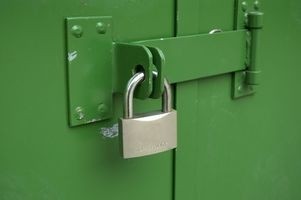Child Home Safety Inspection Checklist

A safety checklist offers parents and other caregivers of children a routine way to ensure that a home is a safe environment. Using a child home safety inspection checklist, the adult can identify items that must be fixed, guarded, locked up, tested, placed out of reach or otherwise safeguarded. Following through on the steps on the checklist protects children living in the home. For foster homes and family home daycare providers, a safety checklist is required by law.
Fire Safety Inspection
A fire safety inspection aims to keep inhabitants safe by making sure fire safety measures are in place. A home must have two exits, and every room in the home should offer easy access to an exit. Obstacles should not block exits, including stairs, doorways and rescue windows.
To prevent fires, adults should store flammable materials and poisons out of children's reach. Homes should be protected with smoke detectors that work properly and with one or more fire extinguishers. All adults in the home should practice with children how to exit the home in case of a fire, and everyone should know where to meet up outside the home.
Locks
Locks prevent small children from accessing areas of the home that could contain hazards, and prevent children from going outside without an adult. A home safety checklist might include high locks on exit doors and barriers to prevent children from entering a pool area. Locks might also be needed to prevent children from accessing functional rooms such as the laundry room, garage, basement and the cellar. Keep locks on areas that contain cleaning liquids, bug sprays and other harmful materials. Be certain that locks will not prevent adults from reaching children in the event of an emergency.
Baby Proofing
Parents and caregivers of small children should use a safety inspection checklist specific to baby proofing a home. A checklist should include putting electrical covers on wall outlets and keeping small objects that may cause choking out of reach. Medicines and other materials that might be mistaken for food should be locked up. Windows and balcony doors need latches or guards, and balconies need protective coverings so children will not squeeze between the bars and fall to the ground below. Stairways must be blocked by safety gates to protect infants and toddlers from falling. Walkways must be kept clear to prevent trips and falls.
Fire Safety Inspection
A fire safety inspection aims to keep inhabitants safe by making sure fire safety measures are in place. A home must have two exits, and every room in the home should offer easy access to an exit. Obstacles should not block exits, including stairs, doorways and rescue windows.
To prevent fires, adults should store flammable materials and poisons out of children's reach. Homes should be protected with smoke detectors that work properly and with one or more fire extinguishers. All adults in the home should practice with children how to exit the home in case of a fire, and everyone should know where to meet up outside the home.
Locks
Locks prevent small children from accessing areas of the home that could contain hazards, and prevent children from going outside without an adult. A home safety checklist might include high locks on exit doors and barriers to prevent children from entering a pool area. Locks might also be needed to prevent children from accessing functional rooms such as the laundry room, garage, basement and the cellar. Keep locks on areas that contain cleaning liquids, bug sprays and other harmful materials. Be certain that locks will not prevent adults from reaching children in the event of an emergency.
Baby Proofing
Parents and caregivers of small children should use a safety inspection checklist specific to baby proofing a home. A checklist should include putting electrical covers on wall outlets and keeping small objects that may cause choking out of reach. Medicines and other materials that might be mistaken for food should be locked up. Windows and balcony doors need latches or guards, and balconies need protective coverings so children will not squeeze between the bars and fall to the ground below. Stairways must be blocked by safety gates to protect infants and toddlers from falling. Walkways must be kept clear to prevent trips and falls.
- l106f3f27763cc93381c66bf978f651756.jpg